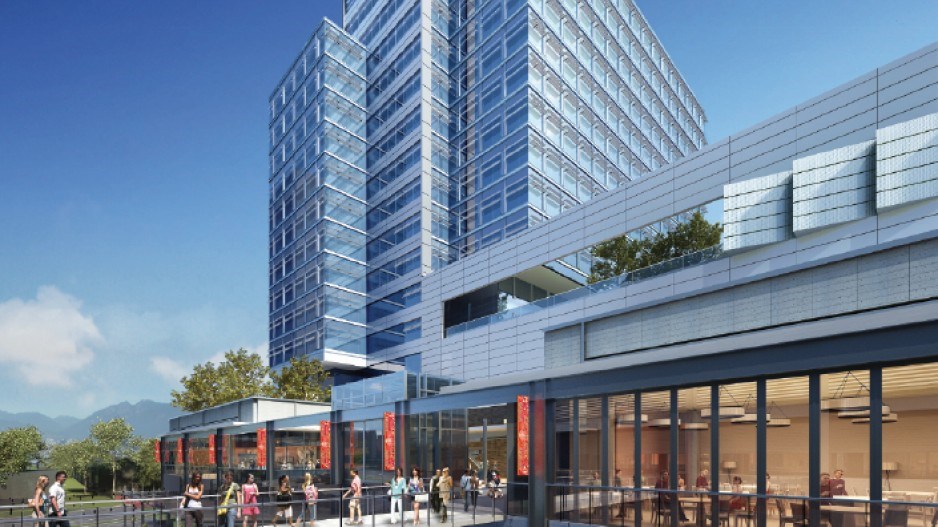Office lull
“Seriously, are there really any growth industries in British Columbia?”
That question from moderator Maury Dubuque at the recent NAIOP panel discussion on the Metro Vancouver office market summarized the grim consensus regarding the current state of demand for space.
Dubuque, senior vice-president, office leasing, for Colliers International, goaded panellists Jeff Rank, a partner with Bentall Kennedy (Canada) LP; Bart Corbett, senior vice-president at Cushman & Wakefield Ltd.; and Norm Taylor, senior vice-president with Jones Lang LaSalle, in a lively discussion that concluded that the region’s office market remains relatively balanced – but also faces slow times between 2015 and 2017.
“We’re not seeing nearly as many people out and active in the market,” Rank said, noting that a number of variables have affected demand, from demand for commodities to the demand for engineering services associated with mining and major projects.
“There’s not a lot of new mandates in the city,” Corbett said. “Renewal activity is about 70% of my business in the downtown core right now. And you can tell the owners in this market still seem somewhat nervous about losing a tenant. ... Demand in this market is still quite low.”
So where is demand coming from?
While mining companies and related firms are returning space to the market, Taylor pointed to Facebook and Twitter as signs of life in the tech sector. Amazon is also poised to lease space (but Taylor was mum despite Dubuque’s prodding).
“We’ve had a great ride, and whether the ride is over is still up for debate,” he said. “We’ve got to make sure we’re keeping our minds open, and looking in other ponds to fish for tenants.”
Government role
Demand for office space depends on having jobs that employ local residents, but new offices might be easier to build than the employment base.
“One of the trends that I’m seeing that is a little bit dangerous in terms of how our market normally operates is some of these buildings have been built as a result of rezoning requirements,” said Jeff Rank of Bentall Kennedy.
He pointed to Marine Gateway, where 247,417 square feet of office space was key to its approval, while the Solo District in Burnaby hinged on inclusion of a 230,000-square-foot office tower.
“We are a much better market ... building when there’s tenant demand,” Rank said. “I think we’re a little ahead of ourselves in some of those suburban markets at this point.”
Government could play a role in supporting demand, either by taking space or attracting new business, but Bart Corbett of Cushman & Wakefield said it seems to be coming up short.
The province isn’t leasing the volume of space it has in years past, while economic development lacks lustre despite Premier Christy Clark’s pledge to attract international head offices to Vancouver.
“We’re doing everything we can to lower taxes, attract new investment, make British Columbia and Vancouver the home for every international headquarters from Asia that we can attract,” Clark pledged to the Urban Development Institute following her election in May. “We are going to build this economy.”
“There is a focus on Asia in government. I don’t know where office demand comes from that,” Corbett said, contrasting the premier’s vision with the incentives Quebec offers businesses that locate in Montreal.
“It’s sad to watch how [Ericsson] is growing their operations in Montreal by two, three, four times, whereas here in Vancouver we’re reducing it by 30%, 40%. They’re getting tax breaks ... so they’re growing their operations there, and they’re not growing it here.”
Access issues
Vancouverites aren’t limited to cars when it comes to commuting, Norm Taylor of Jones Lang LaSalle told NAIOP.
That’s the good news.
But the city’s road projects are the stuff of nightmares.
Jeff Rank of Bentall Kennedy termed viaduct removal “the elephant in the room” when it comes to where companies want to locate – without a fail-safe plan for eastern access to the downtown peninsula, he warned that the city could see office tenants opt to relocate outside the core.
Similarly, reconfiguration of roadways at the south foot of the Burrard Street bridge as well as plans for Point Grey Road are “a nightmare” in Taylor’s words.
“That’s the sole purpose of it,” he said, “to make driving a car difficult.”
While transit connections have helped reduce vehicle use, cars clearly can’t be ruled out entirely for workers who have ground to cover. •




